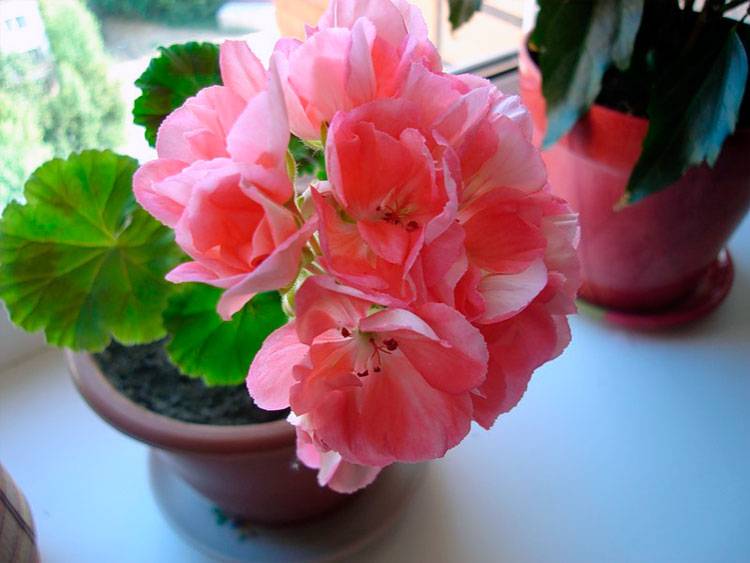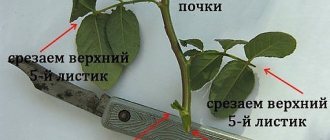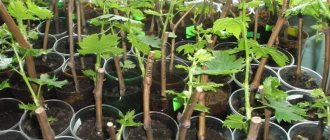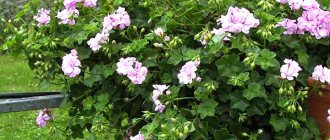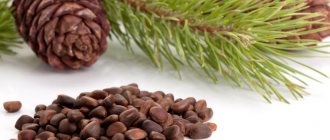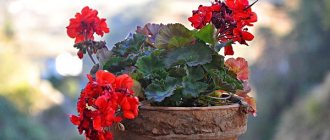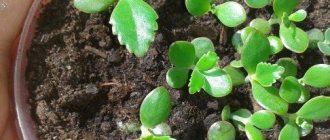How to cut and prepare a scion
Pelargonium can be grown at home for up to 10 years, but most often its trunk is bare, the leaves grow only on the tops of the branches. This is why growers prefer to rejuvenate plants after a few years. With shoots and cuttings, you can grow from 5 to 10 new plants from one mother plant, knowing how to cut and how to root them.
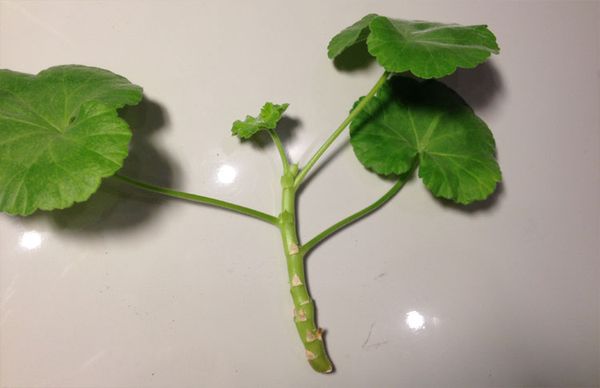
Can you do this all year round? Yes, but the percentage of rooted cuttings is much higher in spring and summer. If the mother plant is in a dormant state, then rooting will occur very slowly, the geranium process may rot. The process occurs much faster at the beginning of the growing season, that is, the best time is from March to May and from July to early September, when the geranium does not bloom already.
The apical shoot can most easily give roots. It is necessary to cut off a twig with 4-5 leaves using a sharp disinfected instrument. Each stalk 5–7 cm long must have several leaves or internodes. Before planting, the lower leaves must be removed, the formed buds must also be removed.
The cuttings are left to lie in the open air for several hours, so that a thin film forms on the cut. Then the cut with the film is treated with charcoal or any rooting agent ("Kornevin", for example).
Care and growing tips
A flower that is quite unpretentious in care can begin to fade if some important points are not taken into account when growing it:
- the pot must correspond to the size of the plant: in a small planter, the root system stops developing;
- lack of drainage and excessive watering can lead to stagnant moisture and the onset of the decay process;
- favorable conditions must be created for the plant: to exclude drafts and provide a sufficient amount of sunlight;
- excessive application of nitrogen fertilizers leads to an increase in green mass and a decrease in flowering.
- watering is carried out regularly, avoiding drying out of the soil, as well as excess moisture;
- geranium does not like spraying;
- it is advisable to replace the topsoil once a year;
- in winter, geranium prefers to be in a cool room;
- for the prevention of diseases and stimulation of flowering, it is necessary to apply complex fertilizers during the growing season twice a month;
- after planting the geranium in the ground and rooting it, you need to pinch the shoot so that the plant quickly begins to take the shape of a bush;
- old geraniums can be rejuvenated by pruning, leaving a stem with several buds from the root;
- a young shoot of geranium, obtained in early spring, will delight in abundant flowering in the summer;
- up to ten new cuttings can be obtained from an old geranium bush, which will become an excellent planting material in flower beds in the garden.
Geranium bushes obtained from cuttings will decorate any flower bed in summer
Rooting methods of the appendix
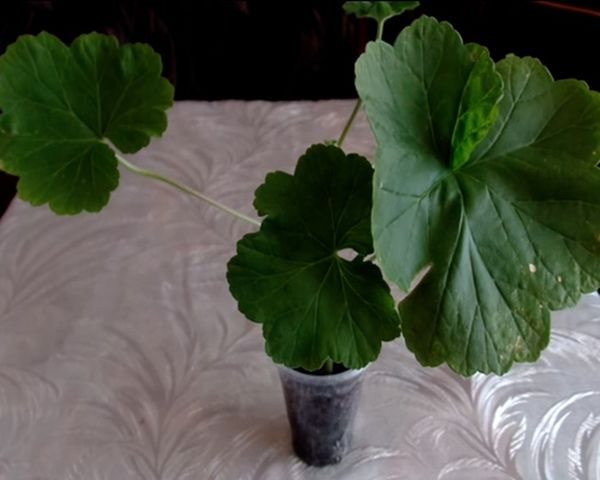

Roots can form in water or soil, the choice of method depends on the type of plant, the season and the wishes of the grower. If we let the scion sit too long in the water, it can rot. For example, royal geraniums form roots in 35–40 days, which means that this method does not suit them.
In water
The cuttings are placed with a dried cut in water (at the level of 4 cm). It is better to take an opaque container, disinfect it before use.The water should be soft, clean, settled, at room temperature (+ 22 ... + 24 ° C), it should be changed after 1–2 days. Some growers argue that when rooting cuttings, you cannot change the water - they say, it's better to just top up. To reduce the risk of stem rotting, crushed activated carbon can be added.
The dishes with the appendix are placed in a lighted place, avoiding direct sunlight. Daylight hours should last at least 16 hours, and at night the temperature should not drop sharply. With this method, it is convenient to observe the growing roots, it is easy to determine the moment of planting in the ground.
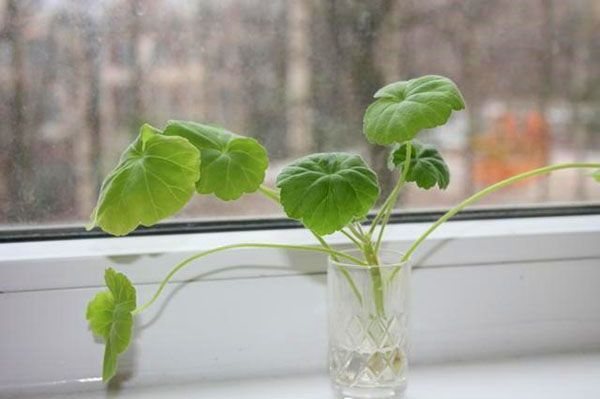

In the ground
If you know how to plant a varietal geranium with a shoot without roots directly in a pot of soil, you can quickly wait for a new plant. Planting prepared geranium shoots should be carried out in nutritious, loose, slightly acidic soil to a depth of 1.5–2 cm. Experienced growers make up a soil mixture of drainage soil, peat and sand, sometimes vermiculite is added. A layer of expanded clay is poured into a pot with drainage holes, then a soil, and a small layer of sand is added on top, which gives some protection against waterlogging of the base of the cutting.
The soil must undergo a decontamination procedure. To do this, it is heated for 20-30 minutes in the oven or poured with a hot solution of potassium permanganate. The pot must also be disinfected before use. It is recommended to use formalin or just boiling water. In the middle, a recess is made with a pencil, a stalk is placed, the soil is firmly pressed against it.
It is not recommended to close the cuttings planted in this way with a jar or plastic wrap, but this can be done if the leaves begin to dry out along the outer edge. After restoring the leaves, the jar is removed. Dishes with sprouts are placed in a bright, warm place - it can be a window sill, only without the draining effect of the central heating battery and without direct sunlight. Water them sparingly after the top layer dries. For irrigation, use clean water at room temperature and a watering can with a narrow spout, directing the water to the ground so that it does not fall on the leaves and stem. Waterlogging threatens the appearance of a black leg, which means the loss of the plant.
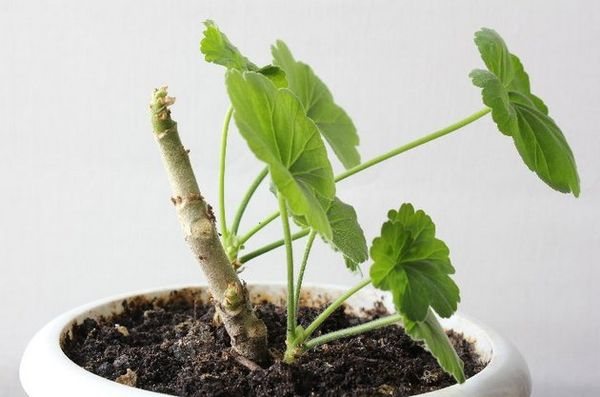

The fact that plants have given roots is signaled by the appearance of new leaves. This can happen in a week or even 3 weeks. From that moment on, they can be transplanted to a permanent place of growth.
Further care
Knowing how to plant geraniums without roots, flower growers often propagate varietal plants purchased at a high price. Plants rooted in water or soil are planted in pots or boxes with an obligatory drainage layer and nutritious loose soil. Caring for them includes creating a comfortable environment with the necessary amount of light, suitable air temperature, with sufficient watering and regular feeding.
So, at home, young plants are most often placed on window sills. They can also decorate balconies, galleries, and plant in a flower bed in summer. The main thing is to provide the plants with at least 16 hours of daylight hours, to protect them from direct sunlight, even when planted outside.
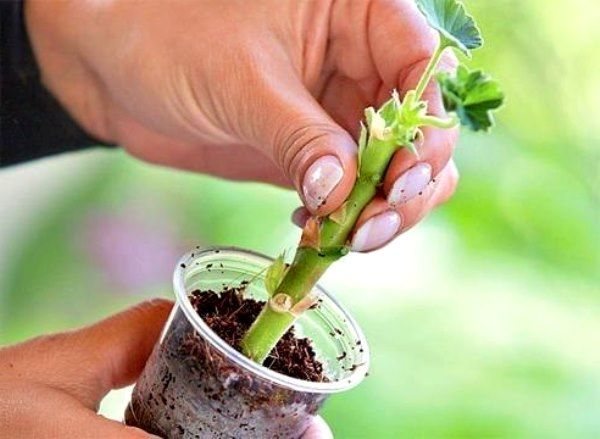

Geranium does not like moisture getting on the leaves, it must be protected from this by spraying neighboring plants, and it must be watered so that the stream of water is directed to the walls of the pot. Young, newly rooted plants are often watered with the bottom method - placing them in a tray of water for 0.5 hours.
It is important to monitor the looseness of the soil, because the roots of pelargonium love to receive fresh air all the time. Top dressing is carried out with special complexes of mineral fertilizers (for example, "Pelargovit") no more often than after 2-3 weeks, simultaneously with watering.
In order for the plants to form lush bushes, they must be carefully pinched with clean hands or disinfected scissors, treating the cut points with activated charcoal.
Young geranium care
Flowering directly depends on the location of the flower. The more sunlight, the more buds are formed on the geranium. In the daytime, the air temperature is maintained in the range of 18-21 ℃ above zero, and at night it is allowed to drop to +13 ℃. If the stems begin to stretch and turn pale, this is the first sign of a lack of light. Watering young geraniums is carried out only with filtered or settled water. Applying cold or hot liquid will rot the root system.
It's important to know! The only nutrient that should be added to the soil after a young plant has rooted is potassium. For geraniums that have reached 2-3 years old, formulations containing: copper, magnesium, manganese, iron are used as top dressing.
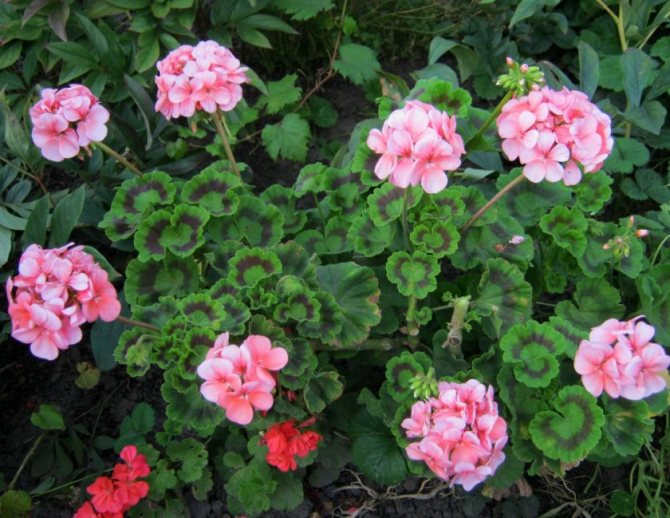

Blooming geranium
Thanks to its beautiful inflorescences, geranium is recognized not only by connoisseurs of indoor species, but also by landscape designers. Creating comfortable conditions and a little patience will allow you to get a real home decoration - blooming geraniums.
Landing features
When to plant or transplant this flower? You should be guided by two criteria:
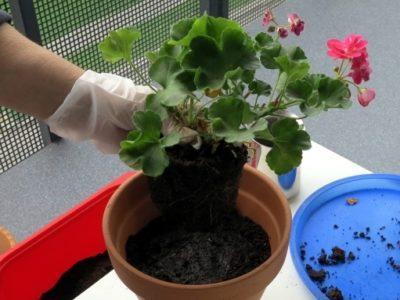

Plant appearance: if a flower grows very slowly, but at the same time proper care is taken, then this most likely means that it is time to plant it in another, larger pot.- Earth inside the pot: if, after watering has been carried out, the earth dries out quickly enough, this means that the roots of the flower have grown, and it is time to change the pot to a larger one.
There is also a universal method that will help determine whether it is time for a transplant or not. You need to get the plant out of the pot, carefully examine the lump of earth. If the roots literally penetrate the ground and there are a lot of them, then it's time to replant the plant.
Watch a video about transplanting geraniums:
General »tips
- Ideally, geraniums are best replanted in the spring.... It is imperative to prepare a larger pot in advance, into which the flower will "move".
- It is not necessary to transplant geraniums into a new pot, but it must be disinfected.... Also, for transplanting geraniums, you will need a watering can with water and fresh soil.
- It is not advisable to transplant geraniums during flowering, but you can... If possible, it is best to avoid it.
- To get a geranium out of an old pot, you must first water it.... And then you need to hold the pot with one hand, and with the other, gently pull the flower. As a last resort, there is an option to use a knife. With its help, you need to very carefully separate the earth from the walls of the pot.
Taking care of geraniums is not so difficult, you just need to know what this flower loves:
- Sunlight (but a light shadow is also not scary for him), he especially tolerates being on the south and east windows.
- Warm weather (but nothing will happen to the flower even with small autumn frosts).
- Watering: infrequent, but abundant.
- The pot must have good drainage.
- Interestingly, the soil should be moderately fertile, even scarce. In other cases, there will be few flowers, but a lot of greenery.
- In order for the geranium to continue to bloom, it is important to remove those inflorescences that have already faded.
- It is important to regularly feed the soil, you need to start feeding in the spring, and continue until the fall once every 2 weeks.
A few words about your beloved geranium
The plant came to us from South Africa itself. Belongs to the Geranium family, can be annual and perennial. Today, about 400 species and varieties of this magnificent flower are known, which became popular all over the world, and 15-16 centuries ago it firmly took a leading position in floriculture.
Morphological signs
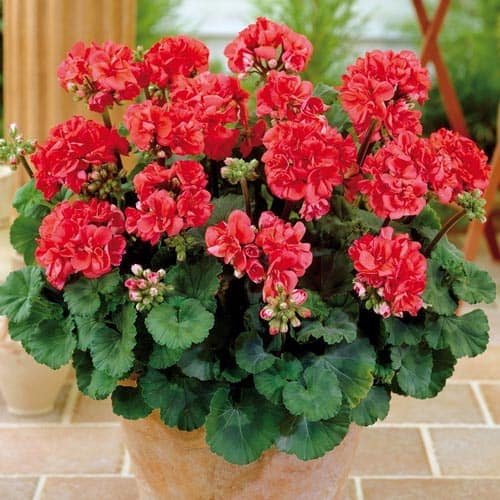

- Many people know geranium (from the Greek "geranos" - "crane") as pelargonium or kalachiki.Most amateur flower growers grow a flower because of its high decorative qualities, but some are also aware of the healing properties of the plant.
- The scent of geranium scares away many harmful insects, and at the same time it is able to eliminate headaches, heal the wound and stop bleeding. It is especially useful to have geranium for hypertensive patients and people suffering from insomnia and increased anxiety.
- In indoor conditions, geranium is a low shrub with a branched crown. The root system has the same structure. Depending on the species and variety, the leaves may differ in color, shape and even size.
- You can find various shades of green, reddish tones, smooth and pubescent foliage. The shape of the sheet can be with small or pronounced cuts along the perimeter of the edge, and there are also types with absolutely solid sheet plates.
- The flowers also differ in different structures: there are simple ones, but there are also double, fluffy ones. They gather in racemose inflorescences and are presented in a wide variety of colors and shades: white, scarlet, bright red, all shades of pink and purple. There are even blue ones.
- At the end of flowering, fruits appear - boxes with oblong seeds. You can collect them from the second half of August to early September.
General advice for growing
Although the plant is considered unpretentious and completely unpretentious, it is worth remembering that Africa and the tropics are its homeland. As a result, it is necessary to know a few basic secrets and rules when growing this spectacular plant.
- Geranium can be safely identified on the south side of the room. The plant simply adores the sun and light. But on especially hot and stuffy days, it is still recommended to shade the flower a little so that the leaves do not get sunburn.
- At the end of autumn and for the entire winter period, move the flowerpot to a cooler room, but the temperature should not be less than +10 degrees, which can be fatal for geraniums.
- Water the geraniums very sparingly. At the same time, the flower categorically does not tolerate spraying and a warm shower.
- To give the flower a more decorative look, regularly pinch the tops of the branches and carry out different types of pruning. It is important to remove faded inflorescences in time.
- If the care fully meets the requirements of the plant, then flowering can be admired throughout the year.
What do you need to know before propagating a flower?
How to propagate? There are several ways geraniums propagate.... But the best is with cuttings or shoots.
Why is this method better? One of the advantages - with this choice, you can see which geranium is in this way - it is clear what will grow in the future. That is, the growth of the plant, what color the flowers will be the leaves. When is it better to take scions? It is possible all year round, best of all in July-August and February-March.
When should you take a shoot from geranium flowers to plant? Before taking a scion, you need to follow a number of simple rules.:


A well-developed specimen of the flower must be chosen as the mother plant, so that rooting takes place, you need to cut off the apical shoot, which has a well-developed growing point. The length of the cutting should be about 7 cm. There should be about 4 leaves on such a cutting. The bottom two must be ripped off.- Then you need to put the cutting in water in order for the roots to form. This usually takes 2-3 weeks.
- Is it possible to plant a stalk without roots in the ground? Oddly enough, yes. But under special conditions. Many of the gardeners, after keeping the shoots in the shade for about a day, and having previously dipped them in crushed coal, you need to plant them in a light mixture at a temperature of + 20 ... + 22 ° С. It takes about a month to wait for rooting in this way.
- It is important to compact the soil well around the seedling and always in a plentiful manner.
- It is important that the scion is provided with good lighting at room temperature.
- How do you know if the cuttings have taken root? If they have new leaves, then this means that their equine system is developed and there is no need to wait any longer. You can transplant the plant into a permanent pot.
Learn more about how to transplant geraniums into another pot and grow from cuttings here.
Everyone's favorite geranium
Like many popular plants, pelargonium came to us from South Africa. And soon it became the beloved Russian geranium, with the same diligence decorating both the narrow window of the village hut and the wide city window sill. Planted on the street, it is a wonderful decoration for any flower bed. In any flower arrangement, geranium successfully takes its rightful place. The development of breeders has made it possible to create numerous hybrids and varieties that differ in the shape, color of leaves and inflorescences.
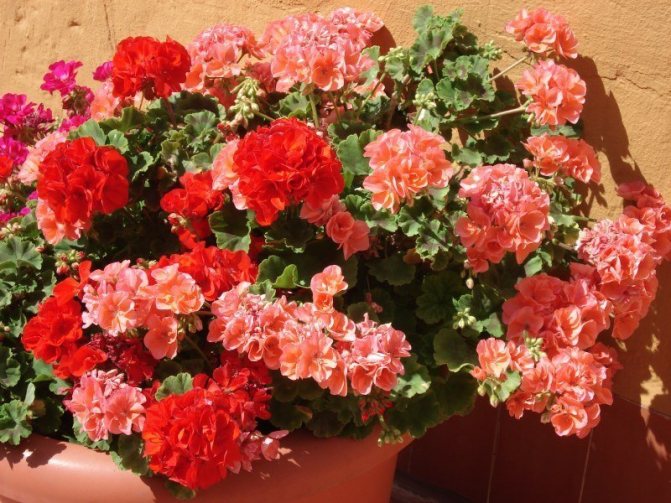

Terry geranium blooms for a long time and abundantly
Important to know: geranium needs replanting every 3 years. If the plant is not renewed, it loses its attractiveness over time: the bush grows densely, the stems become woody, and the abundance of flowering decreases.
Royal, zonal, fragrant, ivy - the main types of pelargonium
- Royal pelargonium is valued for its large inflorescences, which reach a diameter of 15 cm, and the petals of this plant are of different shapes and shades. Cuttings of royal geraniums are carried out according to general principles, but this should be done only in spring or summer. In winter, the plant requires rest and should be stored in a cool, bright room at 15 degrees.
- Zonal pelargonium is prized for its long flowering, which can last almost all year round. The plant is famous for its durability and may not lose its decorative effect for up to 20 years. It is best and fastest to root a stalk of zoned pelargonium in a mixture of sand and peat or perlite.
- Varieties of scented geraniums can differ in color of flowers and shades of smell. The most successful reproduction of this species occurs by cutting the plant in water or dividing the bush in early spring.
- Trumpet geranium (or ivy, ivy) is of interest when grown in hanging pots. The plant bushes well, blooms profusely all summer, its branches can reach a length of 70–90 cm. Reproduction is preferably carried out by cuttings: the shoot will root well in the substrate if the soil is constantly moist. It is better to prepare the soil for the rooted cuttings from a mixture of peat, sand, humus and leafy soil. It is imperative to lay expanded clay at the bottom of the flower dishes.
Photo gallery: a cascade of shapes and colors
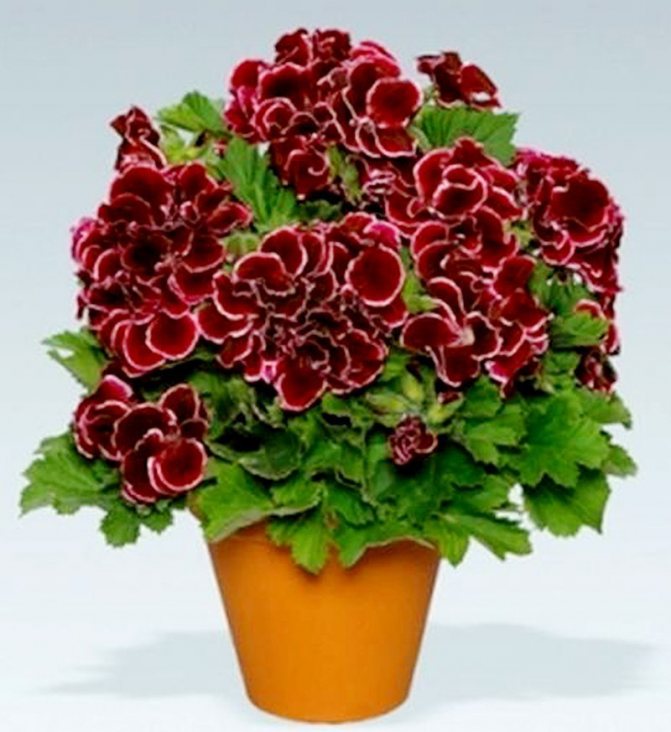

Royal Pelargoniums are powerful bushy plants. Their color is never uniform due to the obligatory presence of dark spots or stripes along the veins. The predominant colors are white, burgundy, dark pink, purple
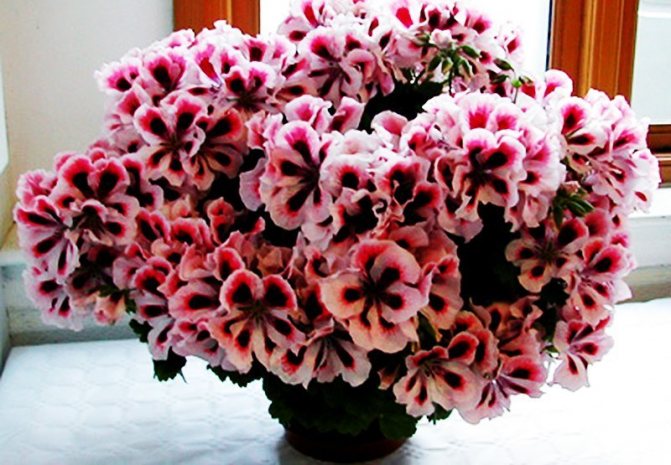

Royal Pelargonium Aztec is distinguished by its very large flowers, in which white edges coexist with dark red spots surrounded by pink highlights in the center. And the extravaganza of colors is completed by a dark cherry openwork mesh spread over the petals


The ivy-leaved pelargonium variety Ville de Dresden, despite its aristocratic appearance, is very unpretentious and feels good in balcony boxes, hanging pots


Pelargonium Angel differs from royal pelargonium by the smaller size of leaves and flowers, it is more persistent and unpretentious
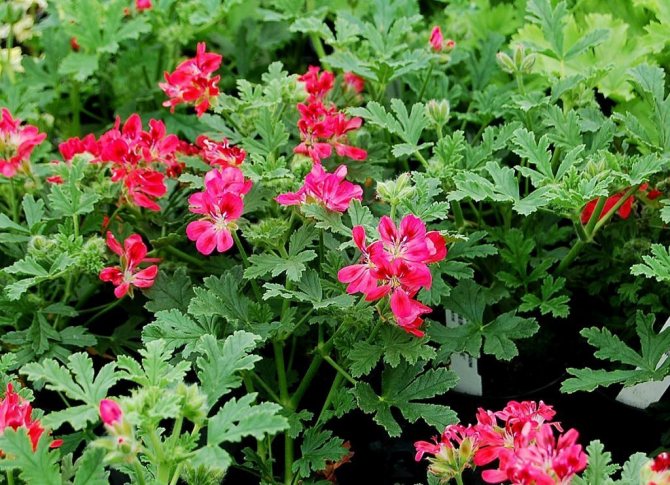

Unicums are an old group of pelargoniums, cultivated since the 18th century. The flowers of the unicums are similar to those of the royal pelargoniums, but smaller in size. The leaves are sometimes fragrant. For example, the leaves of Paton's Unique have a peach aroma.
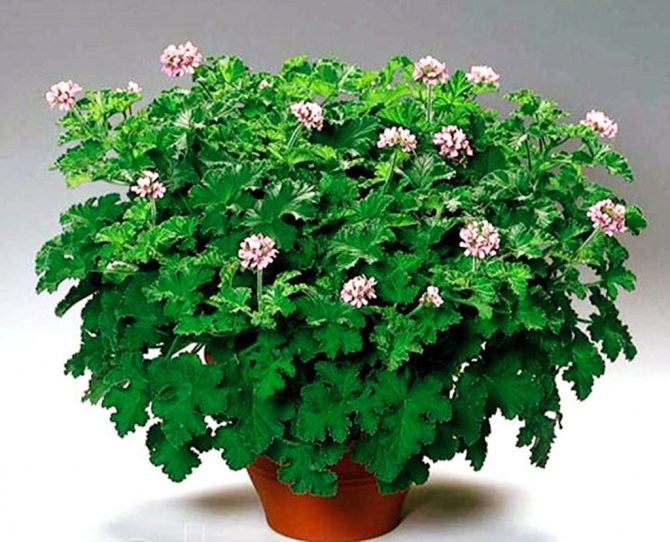

Many varieties of fragrant geranium have been bred, which differ in the shape and color of the leaf blade. The presence of glands on the leaves and stems remained unchanged, which, at the slightest touch, the breath of the breeze, emit an aroma.They smell like apple, rose, cinnamon, lemon, nutmeg. There are over 150 scents that geraniums can produce
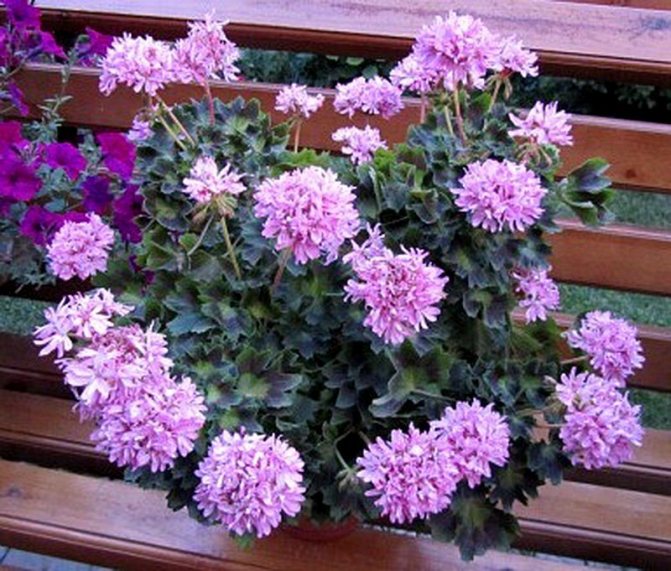

In the star-shaped zonal pelargonium Aunty Pam - Stellar, flowers resemble a double carnation, the petals are painted in an intense neon pink. The bush grows compactly, branches well, blooms profusely with tight bright "caps" on high peduncles
How to plant properly in a pot of soil?
How to plant correctly? First you need to properly prepare for this. To do this, you need to follow the instructions below:
- Sharpen the knife as sharply as possible.
- Carry out a thorough disinfection with medical alcohol.
- Cut the stalk as carefully as possible. Necessarily from the top with 3 to 4 leaves. But by no means with buds! Otherwise, roots will not grow on such shoots for a very long time.
- Put the resulting raw material in the shade for a while. For what? When a new film appears at the cut site.
- Sprinkle the slice with "Kornevin"; if you wish, you can use coal dust instead.
Geranium breeding methods
There are several ways to propagate a plant. Most common: seeds and cuttings. To choose the best option, it is worth considering each in detail.
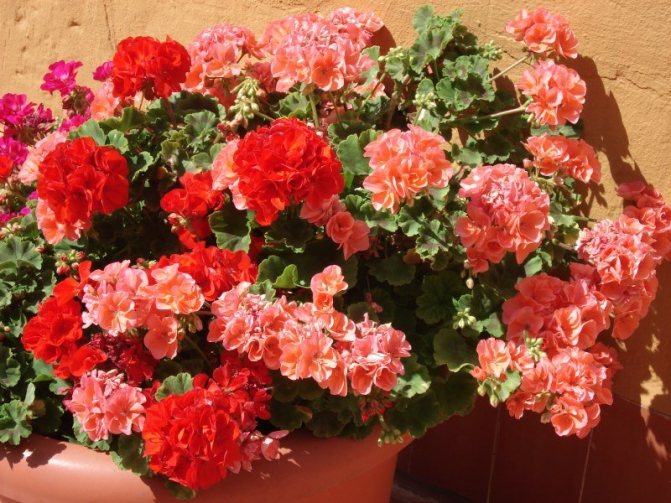

What does indoor geranium look like?
Vegetative (by shoots or cuttings)
In most cases, flower growers propagate pelargonium by grafting, since seed material cannot always convey the parental qualities of a flower. To root geraniums vegetatively? cuttings from the top of the shoots or the middle shoots remaining after pruning are suitable. For propagation, experts recommend seedling containers or ordinary plastic cups.
Important know! The planting container must have drainage holes.
For germination, universal soil is excellent, which is diluted with river sand. For disinfection, change a weak solution of manganese, or pre-calcine the soil.
Generative (seeded)
The seed propagation process is extremely time consuming. It is important to decide before the procedure how to plant geraniums in this way. First of all, attention is paid to the quality of the planting material. It is advisable to purchase seed in specialized stores.
Further care
It is necessary to specially prepare the cups - to make holes in them for water drainage... In addition, due to the holes, air penetrates to the roots, which is also very good.
Next, you need to proceed according to the following instructions:


Add a little vermiculite to slightly wet, damp soil.- Fill each glass with soil,
- In the event that the land was treated with boiling water, of course, you need to wait until it cools down. Fortunately, this does not take much time. Just a few minutes.
- Place the shoots that were previously freed from the lower leaves and deepen them a few centimeters.
- Place the cups on a pallet (so that it is convenient to move them), and place for a while in a dark place,
- After 5 days, the cups need to be transferred to the window. Preferably NOT on the south side.
What if some plants have yellow, limp leaves? You can put them under the jars. That is, to create something like mini-greenhouses for them. Due to the special microclimate, the plants will recover in a couple of days..
When is the best time to do it?
You can experiment at any time of the year. But experienced flower growers believe that geranium takes root faster in spring.
Summer heat affects seedlings negatively, and at high humidity there is a likelihood of developing a "black leg".
It is almost impossible to save the affected plant from the "black leg". The disease develops quickly, the trunk rots from the very root and pruning does not help. When watering, it is best to pour water into the pan to avoid waterlogging the soil.
If geranium is propagated in the fall, it will have to create greenhouse conditions.:
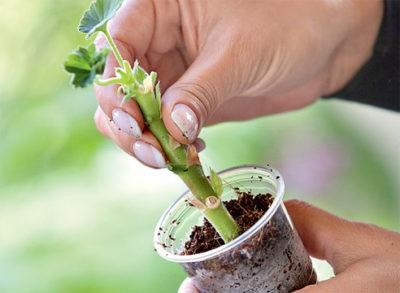

place seedlings under lamps for at least 17 hours a day;- the air must be warmed up to 23 degrees Celsius;
- in autumn, rooting takes longer, amounting to 35-40 days.
So, in order for geranium cuttings to take root well, the period from the end of February to May is considered the best, but your own experience may refute this statement. Rooting is influenced by many factors and each gardener has its own conditions. And yet, in the spring, geranium is always accepted.
Output
It is an easy-care, healthy flower. Therefore, it is worth all lovers of indoor plants to have it at home. Now you know how to grow such a flower at home in a pot.
If you find an error, please select a piece of text and press Ctrl + Enter.
This beautiful plant is found in almost every home. There are many tips on how to plant and care for geraniums. But we will tell you in detail how to plant geraniums with a shoot without roots. However, despite the seeming ease of growing this beautiful plant, there are a few basic rules. Pelargonium (Pelargonium) belongs to the geranium family. Another, more familiar name for this flower is geranium. Both the names "geranium" and "pelargonium" come from the Greek language. The first of them is translated as "stork", and the second as "crane", since the shape of the fruits of plants in its appearance resembles the beak of these animals.
Transfer to a permanent place
Pelargonium ampelous or geranium - growing and care at home
A transplant has an extremely negative effect on the health of the geranium. The general condition of the flower directly depends on the number of transplants. The most suitable time is spring or summer. During winter work, the plant experiences stress, because of which it may not take root.


Geranium seeds
The new container for geraniums should be 3-4 cm larger than the previous one. The plant is transferred to a special substrate by transferring the plant together with an earthen lump. Only shoots are left on the surface. The entire root system must be hidden underground. Using Dyuratek as fertilizer will allow the plant to more easily survive the stress of transplanting and prevent it from rotting.
How to grow geranium from a scion
To grow geraniums from a scion, cuttings of geraniums can be cut from a home plant, purchased from hands or at a specialized exhibition. The exchange of cuttings or the search for collectors on the Internet is gaining great popularity among florists.
You can cut and root the stalk in any geranium variety, and hybrid varieties are propagated only in this way. However, the rooting time will vary. The outgrowth of zonal pelargonium will take root the fastest - in 2 weeks. Royal varieties will give roots in a month. And for fragrant geraniums, this process will take up to 1.5 months.
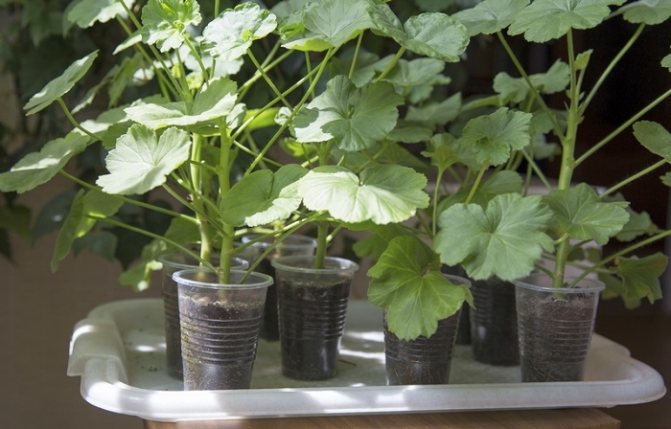

Cuttings of geraniums are used not only for reproduction. From time to time, the plant is recommended to be rejuvenated. Several cuttings are cut from it and planted in one or more containers, and the old bush is thrown away. Young geraniums are more decorative, they bloom more abundantly and retain all the characteristics of the plant from which they were cut. The plant is completely replaced usually after 3-4 years.
Other ways to plant geraniums
Royal geranium - home care for beginners
Other breeding methods are rarely used. Growing from seeds is troublesome, and root division can only be done when transplanting. In some cases, these methods are still resorted to.
Seeds
It is best to grow a seed in a pre-prepared soil. The planting container is filled with nutritious soil and potassium permanganate. Sowing is carried out superficially. It is extremely important to create the right microclimate for growing. Conditions should be close to those of a greenhouse. To do this, take a container with a lid.
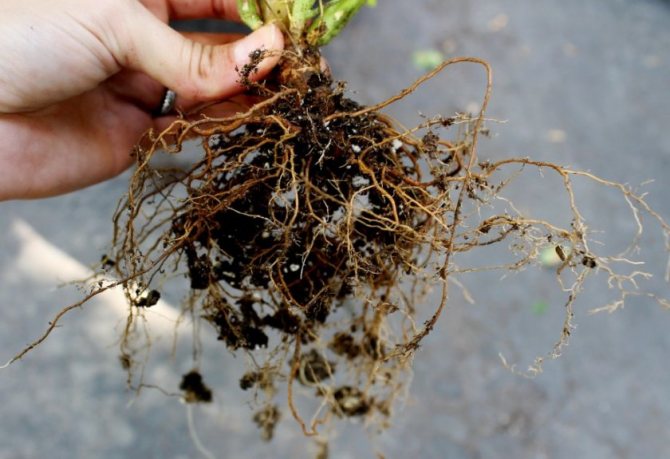

Division of the root system
Additional Information! It is important to provide fresh air to the seeds. Otherwise, they will start to rot.
The transplant is performed after the appearance of the first leaves. It is not easy to grow a healthy plant from seeds at home. When pelargonium has 3-4 full-fledged leaves, it is transplanted into a new container.
By dividing the rhizome
During transplantation, it is convenient to use the method of dividing the bush. The best time to breed in this way is autumn. The flower is completely removed from the pot and divided into several parts as carefully as possible. At the same time, sanitary pruning is done not only for branches, but also for damaged or diseased root processes.
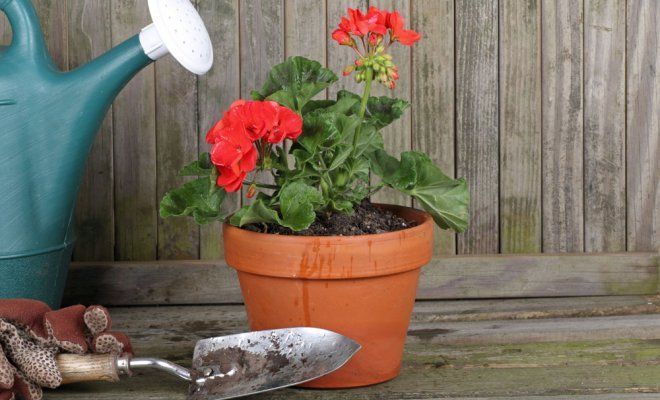

Plant care should be regular.
Harvesting cuttings
The younger the mother plant, the better the chances of rooting its cuttings. Plants over 7 years old may not produce viable shoots at all.
Cuttings can be harvested at any time of the year. Shoots planted in spring, when daylight hours increase, are most likely to take root. During this period, the plants wake up from winter dormancy, they are ready for growth, and active sap flow begins in the tissues. A stalk cut in winter or late autumn will take longer to root, and there will be less chance of success.
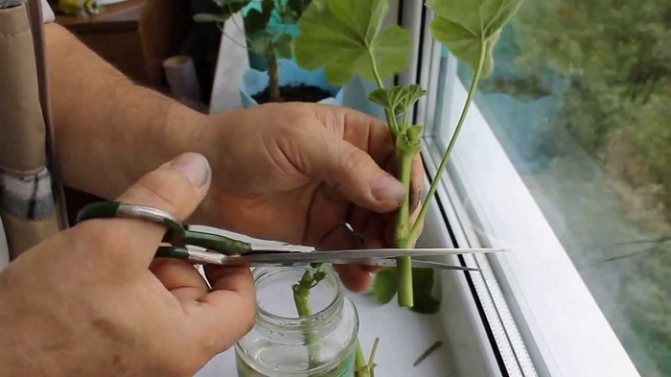

The stalk is cut with a sharp disinfected knife at right angles to the trunk, 1 cm below the node. The shoot should be 5-7 cm long, with 2-3 leaves. If the branch you like already has flowers or buds, they need to be cut, otherwise the plant will spend energy on flowering, and not on the formation of roots.
The resulting shoot is dried before planting for several hours at room temperature in the shade, the cut should be covered with a film. If it is immediately planted in the ground or immersed in water, infection can get on its unprotected surface and there will be a risk of decay. Leaves that are too close to the cut are removed.
How to cut a stalk
Pelargonium can be grown at home for up to 10 years, but most often its trunk is bare, the leaves grow only on the tops of the branches. This is why growers prefer to rejuvenate plants after a few years. With shoots and cuttings, you can grow from 5 to 10 new plants from one mother plant, knowing how to cut and how to root them.
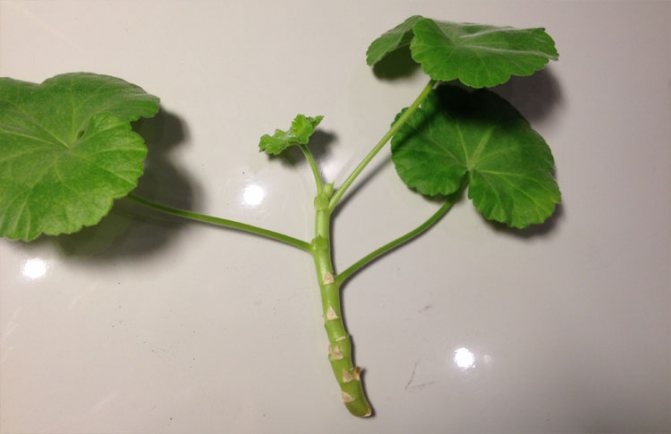

Can you do this all year round? Yes, but the percentage of rooted cuttings is much higher in spring and summer. If the mother plant is in a dormant state, then rooting will occur very slowly, the geranium process may rot. The process occurs much faster at the beginning of the growing season, that is, the best time is from March to May and from July to early September, when the geranium does not bloom already.
The apical shoot can most easily give roots. It is necessary to cut off a twig with 4-5 leaves using a sharp disinfected instrument. Each stalk 5–7 cm long must have several leaves or internodes. Before planting, the lower leaves must be removed, the formed buds must also be removed.
Planting the cuttings in the substrate
Before the propagation of geraniums, a substrate and containers with a height of 10 cm, convenient for keeping in a room, are prepared, which are disinfected with a 1% formalin solution. At the bottom, holes are required to regulate the moisture and aeration of the soil mixture.


After that, a two-layer substrate is formed in the containers. A mixture of sod land and river sand is placed on the bottom layer 6.5 cm high. The washed sand is poured on top with a layer of 2.5 cm. A few hours before planting the cuttings, the soil mixture is poured abundantly with hot water. This event can achieve double results, suppress the growth of pathogenic microorganisms and moisturize the substrate.
The prepared planting material is treated with Kornevin, a growth stimulant. After that, they are placed in a substrate, deepening by 2-3 cm.For the rapid development of adventitious roots, cuttings are placed in a well-lit place without direct sunlight. During this period, the room temperature is maintained between + 15 ° C - + 20 ° C.
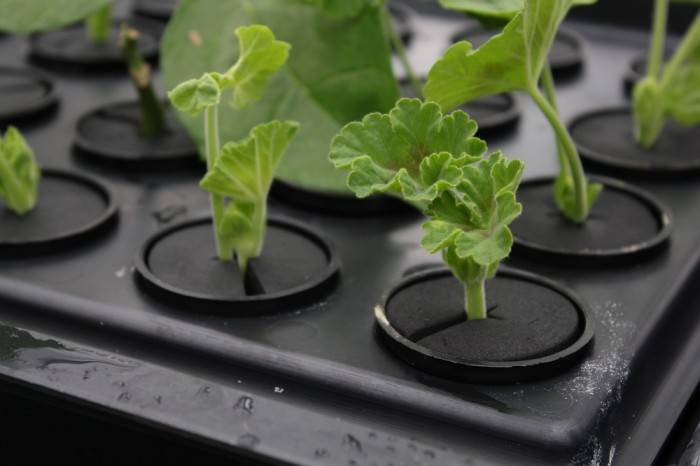

Rooting begins in 2 weeks, and more massive after 20-30 days. The stalk will be completely ready for replanting in 2 months. Do not delay the timing of the transplant. The plant will be much stronger if the main root mass is developed in a permanent place.
Further care
It is necessary to specially prepare the cups - to make holes in them for water drainage. In addition, due to the holes, air penetrates to the roots, which is also very good. Next, you need to proceed according to the following instructions:
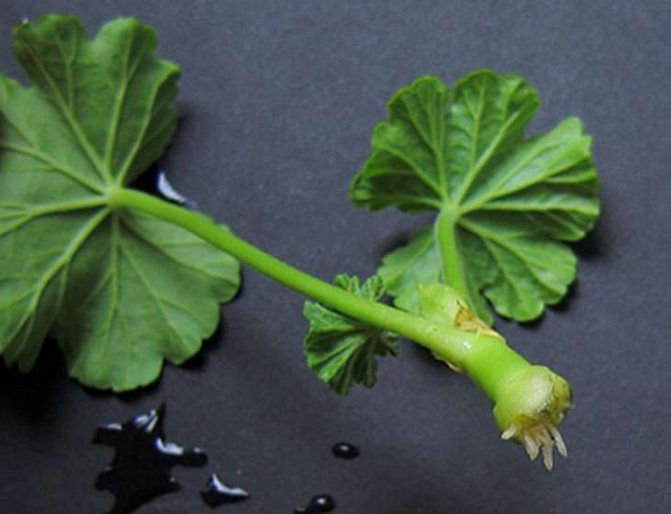

- Add a little vermiculite to slightly wet, damp soil.
- Fill each glass with soil,
- In the event that the land was treated with boiling water, of course, you need to wait until it cools down. Fortunately, this does not take much time. Just a few minutes.
- Place the shoots that were previously freed from the lower leaves and deepen them a few centimeters.
- Place the cups on a pallet (so that it is convenient to move them), and place them for a while in a dark place,
- After 5 days, the cups need to be transferred to the window. Preferably NOT on the south side.
What if some plants have yellow, limp leaves? You can put them under the jars. That is, to create something like mini-greenhouses for them. Due to the special microclimate, the plants will recover in a couple of days.
Reproduction of a plant such as geranium is a fairly simple process that anyone who undertakes it can do. And correct and timely care for a rooted plant will help it delight the eye with its attractive and aesthetic appearance.
>
Features of rooting geranium cuttings in water
With this method, the formation of geranium roots occurs earlier by 2-3 weeks. The planting material is prepared in the recommended way. This is a relatively simple exercise. A significant drawback - relatively high percentage of rotting of the cutting... This risk can be minimized if the procedure is carried out taking into account the biological characteristics of the plant.
The roots of the cuttings will develop better in a container with dark glass and in soft filtered water at room temperature. The stalk is dipped in water only 1.5 -2 cm... With greater immersion, the respiration area of the stem cells decreases, the plant will suffer from a lack of oxygen. This greatly disrupts metabolism and promotes rotting of the cutting.
The water is changed only once a week, if there is intense evaporation, it must be added. A piece of coal is placed in it, which will inhibit the growth of microorganisms. The optimal volume of water for one cutting is 100 ml.
The stalk is planted in the substrate after reaching a root length of 2.5 cm... Keeping it in water longer is not recommended. In the aquatic environment, the roots develop weaker, which in the future may affect the general development of geranium.
The advantage of green cuttings is the complete preservation of the species and varietal characteristics of the parent plant by the plant. The reproduction method opens up a lot of opportunities for creating a new flower garden at home in a short time, without making any special efforts and material costs. This is an opportunity to renew the familiar perennial plants that have become part of the interior.
1decor.org
Tips from experienced florists
Florists say that geranium is the most unpretentious plant, so even beginners can grow it. She does not require certain conditions of detention.
There are several nuances that should be followed:
- winter maintenance should take place at a room temperature of + 15 ° C;
- lowering the air temperature below + 10 ° C can destroy the plant;
- geraniums prefer bright sunlight, so they need to be placed on the lightest window sill;
- the plant must be pinched, as this procedure forces the plant to branch, which has a positive effect on the formation of a bush and the laying of many buds.
Caring for geraniums consists of regular watering, loosening the soil and pruning. If you neglect these manipulations, you cannot get a gorgeous bush with huge caps of flowers.
Related videos:
Possible mistakes to avoid
Many are afraid to root valuable geranium species, fearing they will lose planting material. If you know the main breeding mistakes that inexperienced growers make, you can avoid losses.
How to root geraniums without loss
The best time to root is spring. In this season, rooting is almost 100%. It can also be propagated in other seasons, even in winter, but subject to the presence of additional lighting.
Rooting rules:
- Choosing the right time for rooting. The optimal breeding time is February-March.
- The soil. An important composition of the soil mixture: peat mixed with perlite, proportionally 1: 1.
- Humidity. When overflowing the cuttings, a black leg disease may appear. Therefore, it is important to water in moderation.
- Drying the cut. Before rooting, you need to dry the cut, so it will be easier for the cuttings to form roots.
- During rooting, greenhouse conditions cannot be created. Cuttings die from this.
The fact that the stalk has begun will be evidenced by the roots, which will become clearly visible through the walls of the transparent cup. And also there will be a rapid build-up of green mass.


